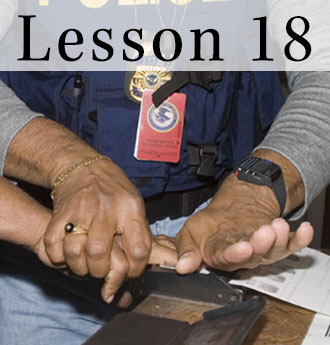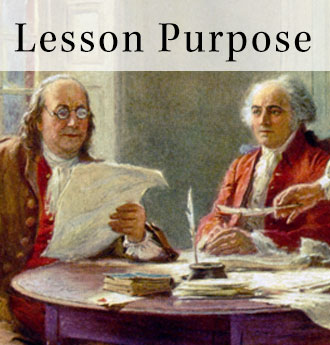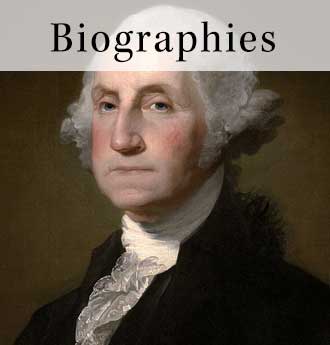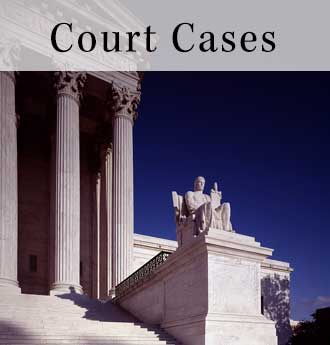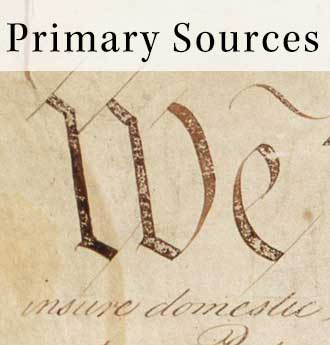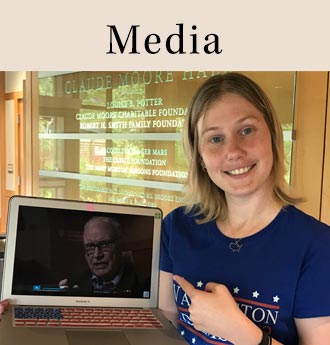Lesson 18: How Has the Due Process Clause of the Fourteenth Amendment Changed the Constitution?
The case summaries below were provided by Oyez and licensed under the Creative Commons Attribution-NonCommercial 4.0 International License. Please visit Oyez.org for more case summaries.
Plessy v. Ferguson (1896)
Facts of the case:
The state of Louisiana enacted a law that required separate railway cars for blacks and whites. In 1892, Homer Adolph Plessy--who was seven-eighths Caucasian--took a seat in a "whites only" car of a Louisiana train. He refused to move to the car reserved for blacks and was arrested.
Case Question:
Is Louisiana's law mandating racial segregation on its trains an unconstitutional infringement on both the privileges and immunities and the equal protection clauses of the Fourteenth Amendment?
Case Conclusion:
No, the state law is within constitutional boundaries. The majority, in an opinion authored by Justice Henry Billings Brown, upheld state-imposed racial segregation. The justices based their decision on the separate-but-equal doctrine, that separate facilities for blacks and whites satisfied the Fourteenth Amendment so long as they were equal. (The phrase, "separate but equal" was not part of the opinion.) Justice Brown conceded that the Fourteenth Amendment intended to establish absolute equality for the races before the law. But Brown noted that "in the nature of things it could not have been intended to abolish distinctions based upon color, or to enforce social, as distinguished from political equality, or a commingling of the two races unsatisfactory to either." In short, segregation does not in itself constitute unlawful discrimination.
Citation:
The Oyez Project, Plessy v. Ferguson, 163 U.S. 537 (1896)
Link to case: http://oyez.org/cases/1851-1900/1895/1895_210
Heart of Atlanta Motel v. United States (1964)
Facts of the case:
Title II of the Civil Rights Act of 1964 forbade racial discrimination by places of public accommodation if their operations affected commerce. The Heart of Atlanta Motel in Atlanta, Georgia, refused to accept black Americans and was charged with violating Title II.
Case Question:
Did Congress, in passing Title II of the 1964 Civil Rights Act, exceed its Commerce Clause powers by depriving motels, such as the Heart of Atlanta, of the right to choose their own customers?
Case Conclusion:
No. The Court held that the Commerce Clause allowed Congress to regulate local incidents of commerce, and that the Civil Right Act of 1964 passed constitutional muster. The Court noted that the applicability of Title II was "carefully limited to enterprises having a direct and substantial relation to the interstate flow of goods and people..." The Court thus concluded that places of public accommodation had no "right" to select guests as they saw fit, free from governmental regulation.
Citation:
The Oyez Project, Heart of Atlanta Motel v. U.S., 379 U.S. 241 (1964)
Link to case: http://oyez.org/cases/1960-1969/1964/1964_515
Dunn v. Blumstein (1972)
Facts of the case:
A Tennessee law required a one-year residence in the state and a three-month residence in the county as a precondition for voting. James Blumstein, a university professor who had recently moved to Tennessee, challenged the law by filing suit against Governor Winfield Dunn and other local officials in federal district court.
Case Question:
Did Tennessee's durational residency requirements violate the equal protection clause of the Fourteenth Amendment?
Case Conclusion:
Yes. In a 6-to-1 decision, the Court held that the law was an unconstitutional infringement upon the right to vote and the right to travel. Applying a strict equal protection test, the Court found that the law did not necessarily promote a compelling state interest. Justice Marshall argued in the majority opinion that the durational residency requirements were neither the least restrictive means available to prevent electoral fraud nor an appropriate method of guaranteeing the existence of "knowledgeable voters" within the state.
Citation:
The Oyez Project, Dunn v. Blumstein, 405 U.S. 330 (1972)
Link to case: http://oyez.org/cases/1970-1979/1971/1971_70_13
Stanton v. Stanton (1975)
Facts of the case:
The case had started in Utah state court. A divorced father stopped paying child support for his daughter when she turned eighteen, so the daughter's mother went to court to ask for support until both the daughter and the son reached twenty-one. Utah divorce court ruled against the mother, and the Utah Supreme Court held that there was a "reasonable basis" for the differential: women matured earlier and married younger; men had a greater need for education. The Utah court stated in its opinion that the basis for the law, though an "old notion," was not unconstitutional.
Case Question:
Does the differing standard for child support violate the equal protection clause?
Case Conclusion:
Yes. Justice Blackmun wrote for the majority. He said the law failed under any standard, including rational basis (the Supreme Court's lowest standard of review). The decision remained in the context of child support, without considering different ages for males and females in other contexts. The Stanton decision placed the Court on record as declaring that society's stereotypes were not a legitimate basis for official policies that treated men and women differently. Blackmun wrote: "A child, male or female, is still a child...No longer is the female destined solely for the home and the rearing of the family, and only the male for the marketplace and the world of ideas...If a specified age of minority is required for the boy in order to assure him parental support while he attains his education and training, so, too, is it for the girl."
Citation:
The Oyez Project, Stanton v. Stanton, 421 U.S. 7 (1975)
Link to case: http://oyez.org/cases/1970-1979/1974/1974_73_1461
University of California Regents v. Bakke (1978)
Facts of the case:
Allan Bakke, a thirty-five-year-old white man, had twice applied for admission to the University of California Medical School at Davis. He was rejected both times. The school reserved sixteen places in each entering class of one hundred for "qualified" minorities, as part of the university's affirmative action program, in an effort to redress longstanding, unfair minority exclusions from the medical profession. Bakke's qualifications (college GPA and test scores) exceeded those of any of the minority students admitted in the two years Bakke's applications were rejected. Bakke contended, first in the California courts, then in the Supreme Court, that he was excluded from admisn solely on the basis of race.
Case Question:
Did the University of California violate the Fourteenth Amendment's equal protection clause, and the Civil Rights Act of 1964, by practicing an affirmative action policy that resulted in the repeated rejection of Bakke's application for admission to its medical school?
Case Conclusion:
No and yes. There was no single majority opinion. Four of the justices contended that any racial quota system supported by government violated the Civil Rights Act of 1964. Justice Lewis F. Powell, Jr., agreed, casting the deciding vote ordering the medical school to admit Bakke. However, in his opinion, Powell argued that the rigid use of racial quotas as employed at the school violated the equal protection clause of the Fourteenth Amendment. The remaining four justices held that the use of race as a criterion in admissions decisions in higher education was constitutionally permissible. Powell joined that opinion as well, contending that the use of race was permissible as one of several admission criteria. So, the Court managed to minimize white opposition to the goal of equality (by finding for Bakke) while extending gains for racial minorities through affirmative action.
Citation:
The Oyez Project, Regents of the University of California v. Bakke, 438 U.S. 265 (1978)
Link to case: https://www.oyez.org/cases/1979/76-811
PGA Tour, Inc. v. Martin (2001)
Facts of the case:
Casey Martin is afflicted with a degenerative circulatory disorder that prevents him from walking golf courses. His disorder constitutes a disability under the Americans with Disabilities Act of 1990 (ADA). When Casey made a request to use a golf cart for the duration of the qualification tournament onto the professional tours sponsored by PGA Tour, Inc., PGA refused. Martin then filed suit under Title III of the ADA, which requires an entity operating "public accommodations" to make "reasonable modifications" in its policies "when...necessary to afford such...accommodations to individuals with disabilities, unless the entity can demonstrate that making such modifications would fundamentally alter the nature of such...accommodations." Ultimately, the district court entered a permanent injunction against PGA, requiring it to allow Martin to use a cart. The court found that the purpose of the PGA's walking rule was to insert fatigue into the skill of shot-making, and that Martin suffered significant fatigue due to his disability, even with the use of a cart. In affirming, the court of appeals concluded that golf courses are places of public accommodation during professional tournaments and that permitting Martin to use a cart would not fundamentally alter the nature of those tournaments.
Case Question:
Does the Americans with Disabilities Act of 1990 provide access to professional golf tournaments by a qualified entrant with a disability? May a disabled contestant be denied the use of a golf cart because it would "fundamentally alter the nature" of the tournaments to allow him to ride when all other contestants must walk?
Case Conclusion:
Yes; no. In a 7-2 opinion delivered by Justice John Paul Stevens, the Court held that Title III of the ADA, by its plain terms, prohibits the PGA from denying Martin equal access to its tours on the basis of his disability and that allowing Martin to use a cart, despite the walking rule, is not a modification that would "fundamentally alter the nature" of the game. "The purpose of the walking rule is...not compromised in the slightest by allowing Martin to use a cart," wrote Justice Stevens, noting Martin's fatiguing disability. Justice Antonin Scalia, joined by Justice Clarence Thomas, dissented.
Citation:
The Oyez Project, PGA Tour v. Martin, 532 U.S. 661 (2001)
Link to case: http://oyez.org/cases/2000-2009/2000/2000_00_24
Gratz v. Bollinger (2003)
Facts of the case:
In 1995, Jennifer Gratz applied to the University of Michigan's College of Literature, Science and the Arts with an adjusted GPA of 3.8 and ACT score of 25. In 1997, Patrick Hamacher applied to the University with an adjusted GPA of 3.0, and an ACT score of 28. Both were denied admission and attended other schools. The University admits that it uses race as a factor in making admissions decisions because it serves a "compelling interest in achieving diversity among its student body." In addition, the University has a policy to admit virtually all qualified applicants who are members of one of three select racial minority groups--African Americans, Hispanics, and Native Americans--that are considered to be "underrepresented" on the campus. Concluding that diversity was a compelling interest, the district court held that the admissions policies for years 1995-1998 were not narrowly tailored, but that the policies in effect in 1999 and 2000 were narrowly tailored. After the decision in Grutter, Gratz and Hamacher petitioned the U.S. Supreme Court.
Case Question:
Does the University of Michigan's use of racial preferences in undergraduate admissions violate the equal protection clause of the Fourteenth Amendment or Title VI of the Civil Rights Act of 1964?
Case Conclusion:
Yes. In a 6-3 opinion delivered by Chief Justice William H. Rehnquist, the Court held that the University of Michigan's use of racial preferences in undergraduate admissions violates both the Equal Protection Clause and Title VI. While rejecting the argument that diversity cannot constitute a compelling state interest, the Court reasoned that the automatic distribution of 20 points, or one-fifth of the points needed to guarantee admission, to every single "underrepresented minority" applicant solely because of race was not narrowly tailored and did not provide the individualized consideration Justice Powell contemplated in Regents of the University of California v. Bakke, 438 U.S. 265 (1978). Chief Justice Rehnquist wrote, "because the University's use of race in its current freshman admissions policy is not narrowly tailored to achieve respondents' asserted compelling interest in diversity, the admissions policy violates the Equal Protection Clause."
Citation:
The Oyez Project, Gratz v. Bollinger, 539 U.S. 244 (2003)
Link to case: https://www.oyez.org/cases/2002/02-516
Grutter v. Bollinger (2003)
Facts of the case:
In 1997, Barbara Grutter, a white resident of Michigan, applied for admission to the University of Michigan Law School. Grutter applied with a 3.8 undergraduate GPA and an LSAT score of 161. She was denied admission. The law school admits that it uses race as a factor in making admissions decisions because it serves a "compelling interest in achieving diversity among its student body." The district court concluded that the law school's stated interest in achieving diversity in the student body was not a compelling one and enjoined its use of race in the admissions process. In reversing, the court of appeals held that Justice Powell's opinion in Regents of the University of California v. Bakke, 438 U.S. 265 (1978), constituted a binding precedent establishing diversity as a compelling governmental interest sufficient under strict scrutiny review to justify the use of racial preferences in admissions. The appellate court also rejected the district court's finding that the Law School's "critical mass" was the functional equivalent of a quota.
Case Question:
Does the University of Michigan Law School's use of racial preferences in student admissions violate the equal protection clause of the Fourteenth Amendment or Title VI of the Civil Rights Act of 1964?
Case Conclusion:
No. In a 5-4 opinion delivered by Justice Sandra Day O'Connor, the Court held that the Equal Protection Clause does not prohibit the law school's narrowly tailored use of race in admissions decisions to further a compelling interest in obtaining the educational benefits that flow from a diverse student body. The Court reasoned that, because the law school conducts highly individualized review of each applicant, no acceptance or rejection is based automatically on a variable such as race and that this process ensures that all factors that may contribute to diversity are meaningfully considered alongside race. Justice O'Connor wrote, "in the context of its individualized inquiry into the possible diversity contributions of all applicants, the Law School's race-conscious admissions program does not unduly harm nonminority applicants."
Citation:
The Oyez Project, Gratz v. Bollinger, 539 U.S. 244 (2003)
Link to case: https://www.oyez.org/cases/2002/02-241
Ricci v. Destefano (2009)
Facts of the case:
White and Hispanic candidates for promotion in the New Haven, Connecticut fire department sued various city officials in the United States District Court for the District of Connecticut when the New Haven Civil Service Board (CSB) failed to certify two exams needed for the plaintiffs' promotion to Lieutenant and Captain. The CSB did not certify because the results of the test would have promoted a disproportionate number of white candidates in comparison to minority candidates. The plaintiffs argued that their rights under Title VII of the Civil Rights Act of 1964, 42 U.S.C. Section 2000e, and the 14th Amendment Equal Protection Clause were violated. On appeal, the Second Circuit court of appeals affirmed the previous decision. It reasoned that the CSB, by refusing to certify the results of the promotional exam, was trying to fulfill its obligations under the rules utilized by the plaintiffs in their argument and therefore was protected in its actions.
Case Question:
1) Can a municipality reject results from an otherwise valid civil service exam when the results unintentionally prevent the promotion of minority candidates? 2) Does 42 U.S.C. Section 2000e permit federal courts to relieve municipalities from having to comply with local laws that require strict compliance with race-blind merit selection procedures?
Case Conclusion:
Maybe--it depends on the facts. Not answered. The Supreme Court held that by discarding the exams, the City of New Haven violated Title VII of the Civil Rights Act of 1964. With Justice Anthony M. Kennedy wrote the majority joined by Chief Justice John G. Roberts, and Justices Antonin G. Scalia, Clarence Thomas, and Samuel A. Alito. Before an employer can engage in intentional discrimination for the purpose of avoiding a "disparate impact" on a protected trait (race, color, religion, national origin), the employer must have a "strong basis in evidence" that it will be subject to "disparate impact liability" if it fails to take the discriminatory action. Here, the Court reasoned that New Haven failed to prove it had a "strong basis in evidence" that failing to discard the results of the exam would have subjected it to liability, as the exams were job-related, consistent with business necessity, and there was no evidence that an equally-valid, less-discriminatory alternative was available. Justice Scalia wrote separately, concurring. He noted that the Court avoided answering whether the "disparate impact" provision of Title VII was consistent with the Equal Protection Clause. Justice Alito also wrote a concurring opinion and was joined by Justices Scalia and Thomas. He criticized the dissent for omitting key information in reaching its alternate conclusion. Justice Ruth Bader Ginsburg dissented and was joined by Justices John Paul Stevens, David H. Souter, and Stephen G. Breyer. She argued that the City of New Haven had good cause to believe it would be vulnerable to a Title VII lawsuit if it certified the exams. Moreover, she criticized the majority for ignoring "substantial flaws" in the exam.
Citation:
The Oyez Project, Ricci v. DeStefano, 557 U.S. (2009)
Link to case: https://www.oyez.org/cases/2008/07-1428
